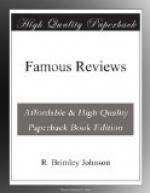And so it is—in due proportion—with Coleridge’s best poems. They are distinguished in a remarkable degree by the perfection of their rhythm and metrical arrangement. The labour bestowed upon this point must have been very great; the tone and quantity of words seem weighed in scales of gold. It will, no doubt, be considered ridiculous by the Fannii and Fanniae of our day to talk of varying the trochee with the iambus, or of resolving either into the tribrach. Yet it is evident to us that these, and even minuter points of accentual scansion, have been regarded by Mr. Coleridge as worthy of study and observation. We do not, of course, mean that rules of this kind were always in his mind while composing, any more than that an expert disputant is always thinking of the distinctions of mood and figure, whilst arguing; but we certainly believe that Mr. Coleridge has almost from the commencement of his poetic life looked upon versification as constituting in and by itself a much more important branch of the art poetic than most of his eminent contemporaries appear to have done. And this more careful study shows itself in him in no technical peculiarities or fantastic whims, against which the genius of our language revolts; but in a more exact adaptation of the movement to the feeling, and in a finer selection of particular words with reference to their local fitness for sense and sound. Some of his poems are complete models of versification, exquisitely easy to all appearance, and subservient to the meaning, and yet so subtle in the links and transitions of the parts as to make it impossible to produce the same effect merely by imitating the syllabic metre as it stands on the surface. The secret of the sweetness lies within, and is involved in the feeling. It is this remarkable power of making his verse musical that gives a peculiar character to Mr. Coleridge’s lyric poems. In some of the smaller pieces, as the conclusion of the “Kubla




